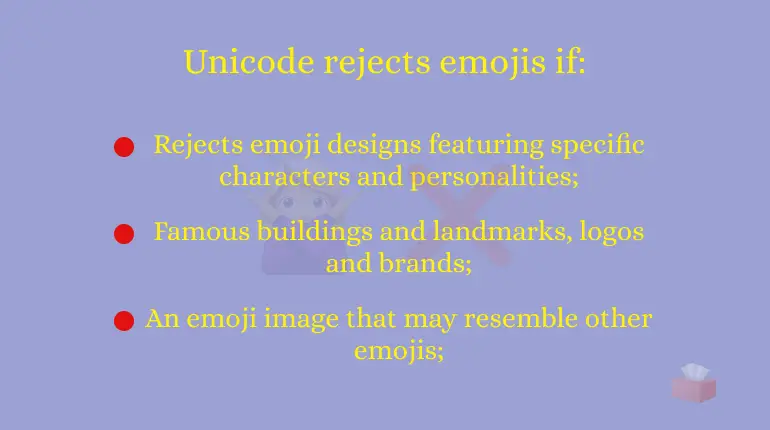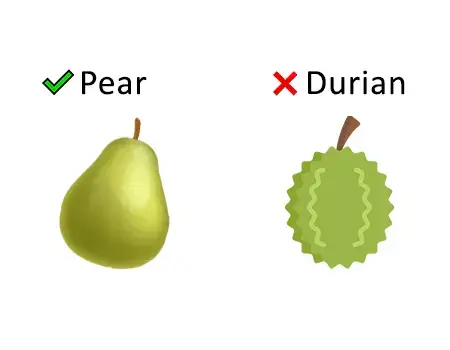🙅♀️ Defected emojis: which emojis are rejected by Unicode?
Every year, from the beginning of April to the end of July, hundreds of applications for new emoji are submitted to the Unicode subcommittee. Interestingly, anyone can submit his or her idea of an emoji. But, it is well-known that the consortium approves and then encodes only a limited number of sketches.
What should be taken into account when creating an emoji, so that the smiley appears on smartphones? This article will help you better understand this, as it looks at several emoji designs which were successful in their meaning, but were blocked by the experts, and the possible reasons for their rejection.relevance; uniqueness; the likelihood of filling the semantic gap in types and categories; compatibility with commonly used emojis; familiarity; presence of metaphorical references; possibility of common use; use in sequences to create new images; and more. Unicode also rejects designs featuring specific characters and personalities, famous buildings and landmarks, logos and brands. A complete and detailed list of requirements can be found on the corporation's official page.

Reasons for rejecting emoji from Unicode
The emoji is applicable in conversations about nutrition and 💪 sports, goes with almost all fruit emojis and fills a gap in the category. But the realization of the project itself can hardly be considered ideal and recognizable. Therefore, the graphic implementation of the yogurt will probably have to be improved.
Hummus can also be called an unfortunate emoji version, the image of which may resemble other various sauces and snacks, and does not quite accurately convey the idea. It is obvious that the use of the emoji of the beloved national chickpea snack presented in such a way may not become global.
The durian and spinach emojis were also rejected. The first candidate has a design similar to the 🍐 Pear emoji, and in the monochrome version looked like an image of a lychee. Spinach was rejected because it resembles the 🍃 "Leaf Fluttering in wind" and 🥬 "Green salad" emojis.

Approved and declined emojis
Pasta completes the food theme: a candidate got excluded because it is a variant of another emoji, 🍝 Spaghetti. For the same reason, by the way, the Shiba-Inu emoji, as another breed of 🐕 dog; ukulele, as a similar emoji to the 🎸 Guitar; and city park variants of emojis were rejected.
Indicative among those rejected is the emoji of Sherlock Holmes, the famous hero of short stories, movies and computer games. The emoji did not fit two criteria at once. First, the character, although fictional, is a specific person, which is forbidden by the rules. Secondly, there is already a 🕵️ Detective emoji in Unicode and the sentence could be considered a duplicate.
Finally, the napkin box emoji. Seems like this candidate should be ideal in everything - from its eligibility to design. But the proposal has so far been rejected. Perhaps, because the napkins in the drawing are placed in a box, of which there are already quite a lot among the emojis?
In any case, before you apply with an emoji to the Unicode Consortium, do take your time to go through the rules once again, as knowing them well will surely help you succeed and witness your own emoji idea brought to life.
What should be taken into account when creating an emoji, so that the smiley appears on smartphones? This article will help you better understand this, as it looks at several emoji designs which were successful in their meaning, but were blocked by the experts, and the possible reasons for their rejection.
The basics about the selection criteria
It is assumed that the emoji candidates on the list for approval do not replicate existing emoji designs, do not resemble ideas that have been rejected in the last 2 years, and have passed the required documentation. Unicode representatives further evaluate:
Examples of rejected emojis
The list of emoticons that did not become official emojis can begin with the "Food" section and its representative called "yogurt". The popular fermented dairy product, often with added sugar and 🍒 Fruit, is considered healthy and is constantly on Google search trends.The emoji is applicable in conversations about nutrition and 💪 sports, goes with almost all fruit emojis and fills a gap in the category. But the realization of the project itself can hardly be considered ideal and recognizable. Therefore, the graphic implementation of the yogurt will probably have to be improved.
Hummus can also be called an unfortunate emoji version, the image of which may resemble other various sauces and snacks, and does not quite accurately convey the idea. It is obvious that the use of the emoji of the beloved national chickpea snack presented in such a way may not become global.
The durian and spinach emojis were also rejected. The first candidate has a design similar to the 🍐 Pear emoji, and in the monochrome version looked like an image of a lychee. Spinach was rejected because it resembles the 🍃 "Leaf Fluttering in wind" and 🥬 "Green salad" emojis.

Pasta completes the food theme: a candidate got excluded because it is a variant of another emoji, 🍝 Spaghetti. For the same reason, by the way, the Shiba-Inu emoji, as another breed of 🐕 dog; ukulele, as a similar emoji to the 🎸 Guitar; and city park variants of emojis were rejected.
Indicative among those rejected is the emoji of Sherlock Holmes, the famous hero of short stories, movies and computer games. The emoji did not fit two criteria at once. First, the character, although fictional, is a specific person, which is forbidden by the rules. Secondly, there is already a 🕵️ Detective emoji in Unicode and the sentence could be considered a duplicate.
Finally, the napkin box emoji. Seems like this candidate should be ideal in everything - from its eligibility to design. But the proposal has so far been rejected. Perhaps, because the napkins in the drawing are placed in a box, of which there are already quite a lot among the emojis?
In any case, before you apply with an emoji to the Unicode Consortium, do take your time to go through the rules once again, as knowing them well will surely help you succeed and witness your own emoji idea brought to life.

